Porsche Automobil Holding Bundle
How Did Porsche Automobil Holding Shape the Automotive World?
Dive into the captivating history of Porsche Automobil Holding SE, a company whose strategic vision has profoundly impacted the automotive industry. From its roots in engineering excellence to its current position as a major player, Porsche SE's journey is a testament to enduring leadership. Discover how this holding company, with its significant stake in Volkswagen AG, continues to shape the future of mobility.
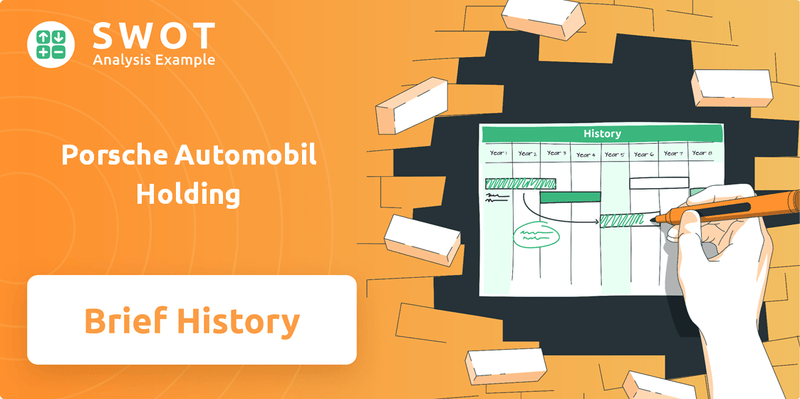
Ferdinand Porsche's legacy began in 1931, establishing the foundation for what would become a global automotive powerhouse. This Porsche Automobil Holding SWOT Analysis explores the company's early years and development, highlighting its commitment to innovation. Understanding the Porsche history is crucial to grasping its influence within the automotive industry and its pivotal role in the Volkswagen Group, showcasing the enduring impact of the Porsche family.
What is the Porsche Automobil Holding Founding Story?
The story of Porsche Automobil Holding SE begins with a visionary engineer, Ferdinand Porsche. His ambition led to the establishment of a company that would significantly impact the automotive industry. The company's roots are deeply intertwined with innovation and a commitment to engineering excellence.
Officially founded on April 25, 1931, in Stuttgart, Germany, the company initially operated under the name 'Dr. Ing. h.c. F. Porsche GmbH, Konstruktionsbüro für Motoren-, Fahrzeug-, Luftfahrzeug- und Wasserfahrzeugbau.' Ferdinand Porsche, with his extensive experience from Daimler-Benz and Austro-Daimler, brought a wealth of knowledge to his new venture. His expertise included designing successful race cars and pioneering production vehicles, setting the stage for a legacy of high-performance automobiles.
Ferdinand Porsche identified a need for advanced automotive engineering and design services independent of specific manufacturers. He saw an opportunity to provide innovative solutions to the growing German automotive industry. The initial business model focused on offering engineering consulting, design, and development services for various types of vehicles and engines. The company's first significant project, the design of the 'Volks-Wagen,' later known as the Volkswagen Beetle, solidified its reputation for practical and efficient engineering.
Ferdinand Porsche's vision and engineering prowess laid the groundwork for a company that would become synonymous with luxury and performance. The initial focus was on providing engineering services, with the Volkswagen project being a pivotal moment.
- The company's founding was driven by Ferdinand Porsche's expertise and a desire for independent automotive design services.
- The Volkswagen project was crucial in establishing the company's reputation.
- Early funding came from Ferdinand Porsche himself, along with associates.
- The 'Porsche' brand as a car manufacturer would later emerge, spearheaded by Ferry Porsche.
Initial funding for Dr. Ing. h.c. F. Porsche GmbH came from Ferdinand Porsche, along with financial backing from Adolf Rosenberger and Anton Piëch, his son-in-law. This early funding structure was akin to bootstrapping, relying on personal capital and close associates. The company name reflected Ferdinand Porsche's personal involvement, while the 'Porsche' brand as a car manufacturer would later be developed by his son, Ferry Porsche. The cultural context of the 1930s in Germany, with its emphasis on industrial growth and national projects, significantly influenced the company's creation and its initial focus on large-scale engineering endeavors like the Volkswagen project.
The relationship between Porsche and Volkswagen is a key part of Competitors Landscape of Porsche Automobil Holding. This collaboration played a crucial role in the early success of Porsche. The influence of the Porsche family has been instrumental in shaping the company's direction and values. The evolution of Porsche's ownership structure reflects its growth and adaptation within the automotive industry.
The current structure of Porsche Holding SE and the difference between Porsche AG and Porsche Holding SE are important aspects to understand. Porsche's involvement in motorsport history has significantly contributed to its brand image and technological advancements. Key figures in Porsche's history, such as Ferdinand and Ferry Porsche, have left an indelible mark on the company.
Porsche Automobil Holding SWOT Analysis
- Complete SWOT Breakdown
- Fully Customizable
- Editable in Excel & Word
- Professional Formatting
- Investor-Ready Format
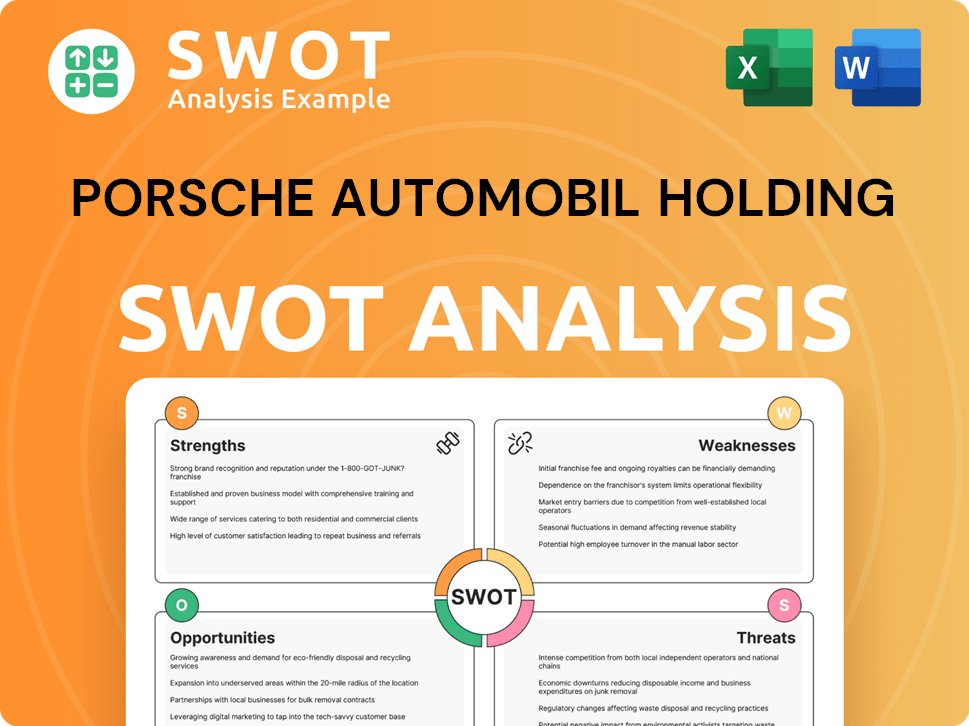
What Drove the Early Growth of Porsche Automobil Holding?
The early growth of Dr. Ing. h.c. F. Porsche GmbH, which later evolved into Porsche Automobil Holding, was marked by significant engineering achievements. Initially focused on engineering contracts, the company's design of the Volkswagen Beetle was a pivotal project. After facing challenges post-World War II, the company expanded into manufacturing its own cars. This period laid the groundwork for the future of Porsche and its role in the automotive industry.
The company's early years were defined by its engineering prowess. The design of the Volkswagen Beetle, though not directly branded as a Porsche, showcased the company's technical capabilities. This project was crucial in establishing its reputation and providing a foundation for future automotive ventures. The initial team consisted of skilled engineers and designers, working on various projects.
Ferry Porsche, Ferdinand's son, spearheaded the move into car manufacturing. The launch of the Porsche 356 in 1948 marked a shift from engineering consulting to producing cars under the Porsche name. Early sales grew steadily, attracting a dedicated customer base. Production initially took place in Gmünd, Austria, before the company returned to Stuttgart, Germany.
The 1950s and 1960s saw Porsche expand its product line, with the introduction of the iconic 911 in 1963. This model became a cornerstone of the brand. The company expanded its team and dealer network. Porsche's success in motorsports further boosted its brand image and sales. The company largely relied on internal financing and reinvestment of profits for its growth.
Market reception for Porsche sports cars was overwhelmingly positive, establishing a niche for high-performance, quality vehicles. The competitive landscape included other luxury and sports car manufacturers. Porsche carved out its unique position through its distinct engineering philosophy and racing success. This early growth period was characterized by a clear strategic focus on performance and innovation.
Porsche Automobil Holding PESTLE Analysis
- Covers All 6 PESTLE Categories
- No Research Needed – Save Hours of Work
- Built by Experts, Trusted by Consultants
- Instant Download, Ready to Use
- 100% Editable, Fully Customizable
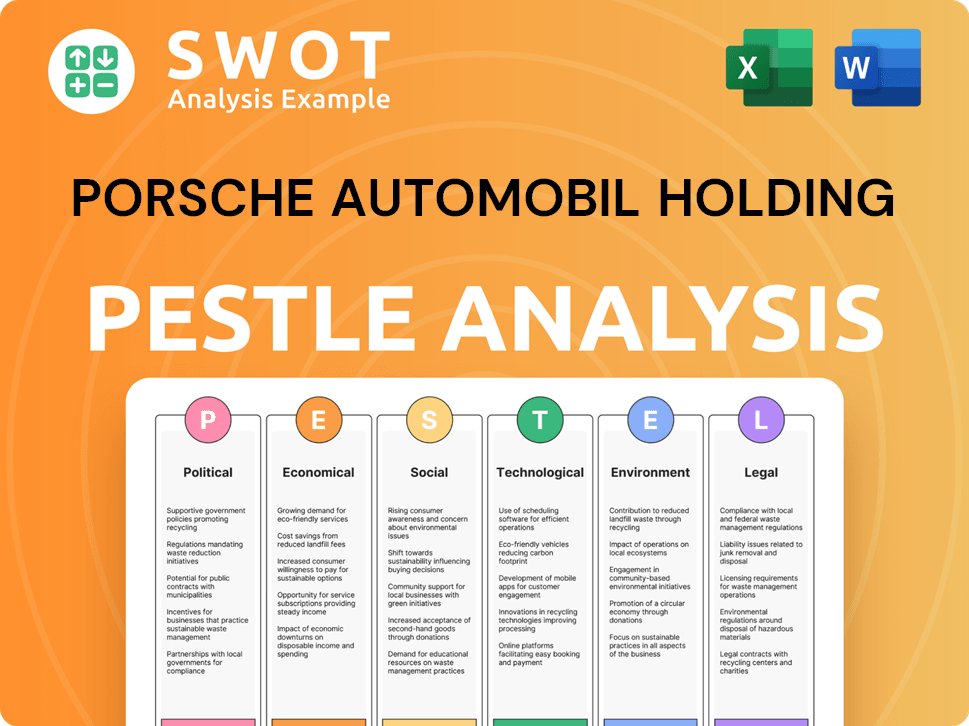
What are the key Milestones in Porsche Automobil Holding history?
The story of Porsche Automobil Holding is marked by significant milestones, from its early sports car ventures to its strategic moves within the automotive industry. This journey reflects the company's adaptability and its ability to navigate complex market dynamics, solidifying its position within the Volkswagen Group.
| Year | Milestone |
|---|---|
| 1948 | Launch of the Porsche 356, marking the beginning of Porsche's sports car manufacturing. |
| 1963 | Introduction of the Porsche 911, which set a benchmark for sports car design and engineering. |
| 1975 | The 911 Turbo was introduced, the first production car with a turbocharged engine. |
| Early 1990s | The company faced financial difficulties, leading to restructuring and the introduction of the Boxster. |
| Ongoing | Porsche Automobil Holding SE became the majority voting rights holder in Volkswagen AG, transforming the company into a holding entity. |
Porsche has consistently demonstrated a commitment to innovation, particularly in automotive engineering. The company's advancements include pioneering engine designs, aerodynamic improvements, and enhanced vehicle safety features. These innovations have not only improved vehicle performance but also set new standards in the automotive sector.
Porsche's initial design work on the Volkswagen Beetle was a groundbreaking achievement in mass-market automotive engineering, influencing the industry significantly.
The launch of the Porsche 356 in 1948 marked the company's entry into sports car manufacturing, laying the foundation for its iconic status and establishing the brand's identity.
The introduction of the Porsche 911 in 1963 was a revolutionary moment, establishing a design and engineering benchmark that continues to influence sports car development worldwide.
Porsche's innovation included the Tiptronic automatic transmission, enhancing driving experience and demonstrating the company's commitment to technological leadership in the automotive industry.
The 911 Turbo, introduced in 1975, was the first production car with a turbocharged engine, showcasing Porsche's pioneering spirit in performance and engine technology.
Porsche secured numerous patents related to engine design, aerodynamics, and vehicle safety, highlighting its dedication to innovation and technological advancement.
Porsche Automobil Holding has faced various challenges, including economic downturns and shifting market demands. The company has demonstrated resilience by adapting its strategies, diversifying its product range, and making strategic investments. For instance, in 2024, the Volkswagen Group, in which Porsche holds a significant stake, reported a strong financial performance, indicating the positive impact of strategic decisions.
The global oil crises of the 1970s and early 1980s significantly impacted sports car sales, forcing Porsche to diversify its product line and explore more fuel-efficient options to stay competitive.
Economic downturns and intense competition from other luxury car manufacturers necessitated strategic pivots, requiring Porsche to adapt its business strategies to maintain market share and profitability.
In the early 1990s, the company faced financial difficulties, leading to significant restructuring efforts, including cost-cutting measures and the introduction of new models like the Boxster.
Porsche's increasing stake in Volkswagen AG, culminating in Porsche Automobil Holding SE becoming the majority voting rights holder, transformed Porsche into a powerful automotive holding company.
The strategic shift presented its own challenges, including complex financial maneuvers and regulatory scrutiny, requiring Porsche to navigate intricate financial and legal landscapes.
Through these experiences, Porsche honed its ability to adapt to changing market conditions, diversify its portfolio, and leverage its engineering expertise to overcome obstacles, ensuring its long-term sustainability.
The relationship between Porsche and Volkswagen has been central to its evolution. The strategic decisions made by the Porsche family and the company's leadership have been crucial in shaping its trajectory within the automotive industry. To understand more about the core values that guide Porsche Automobil Holding, you can read about Mission, Vision & Core Values of Porsche Automobil Holding.
Porsche Automobil Holding Business Model Canvas
- Complete 9-Block Business Model Canvas
- Effortlessly Communicate Your Business Strategy
- Investor-Ready BMC Format
- 100% Editable and Customizable
- Clear and Structured Layout
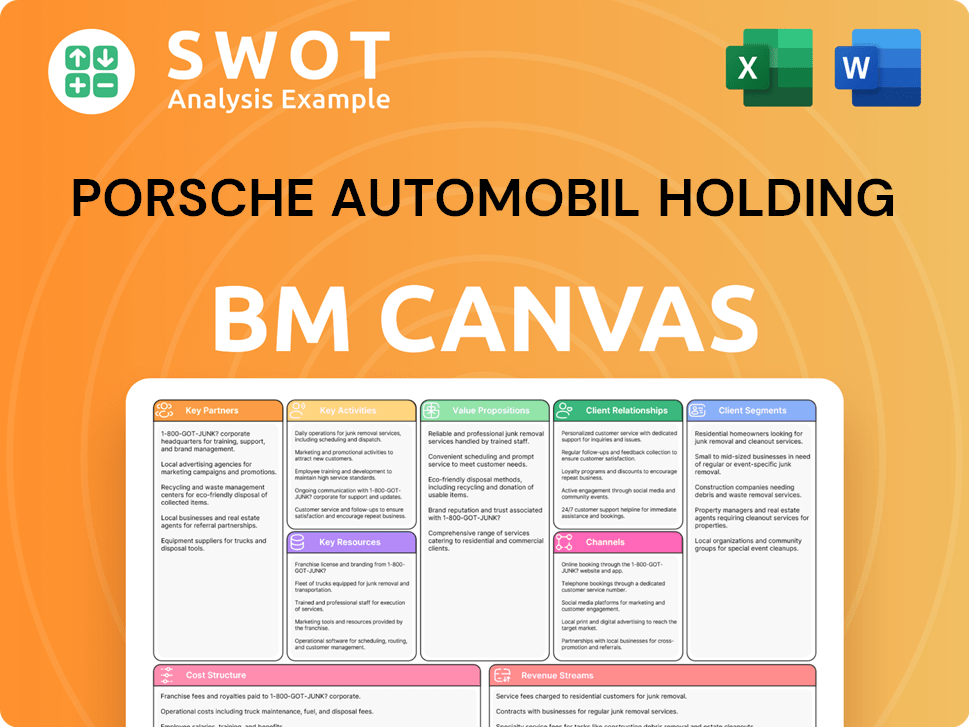
What is the Timeline of Key Events for Porsche Automobil Holding?
The journey of Porsche Automobil Holding SE is marked by strategic shifts and pivotal moments that have shaped its identity within the automotive industry. From its inception as an engineering design office to its current status as a holding company with a significant stake in Volkswagen AG, Porsche's history reflects a commitment to innovation and strategic foresight. This evolution has been influenced by the Porsche family, market demands, and the ever-changing landscape of the automotive industry, making it a subject of interest for those studying the Target Market of Porsche Automobil Holding.
| Year | Key Event |
|---|---|
| 1931 | Dr. Ing. h.c. F. Porsche GmbH was founded in Stuttgart, Germany, initiating the company's automotive engineering design operations. |
| 1934 | Ferdinand Porsche secured a contract for the 'Volks-Wagen' project, laying the groundwork for future automotive endeavors. |
| 1948 | The first Porsche-branded sports car, the Porsche 356, was launched, marking the beginning of Porsche history. |
| 1963 | The iconic Porsche 911 was introduced, becoming a benchmark for sports cars worldwide. |
| 1972 | Porsche KG transitioned into a stock corporation, Porsche AG, separating the family's operational control. |
| 1975 | The Porsche 911 Turbo, one of the first production cars with a turbocharged engine, was launched. |
| 1996 | The Porsche Boxster was introduced, expanding the company's product portfolio and market reach. |
| 2005 | Porsche SE was established as a holding company, beginning to acquire shares in Volkswagen AG. |
| 2009 | Porsche SE became the majority voting rights holder in Volkswagen AG, solidifying its influence. |
| 2012 | Volkswagen AG acquired the remaining 50.1% of Porsche AG, making it a wholly-owned subsidiary, while Porsche SE retained its holding company structure. |
| 2022 | Porsche AG went public, with Porsche SE remaining the anchor investor and majority voting rights holder in Volkswagen AG. |
| 2024-2025 | Porsche SE continues its strategic focus on its investment in Volkswagen AG, emphasizing electric mobility, digitalization, and sustainable production within the Volkswagen Group. |
Porsche SE's future is closely tied to the electric vehicle (EV) market. The Volkswagen Group plans to invest €180 billion from 2023-2027 in areas like EV development. This strategic alignment positions Porsche SE to benefit from the increasing demand for electric vehicles and sustainable mobility solutions.
The Volkswagen Group, and by extension, Porsche SE, is focused on strengthening its presence in key growth markets. This includes significant expansion in China and North America, with a specific emphasis on growing EV sales. This expansion is crucial for long-term value creation.
Several industry trends will significantly impact Porsche SE, including increasing regulatory pressure for emissions reduction and the rise of connected and autonomous vehicle technologies. These trends are expected to drive further growth in the EV segment, benefiting Porsche SE's investment in the Volkswagen Group's electrification strategy.
Porsche SE is committed to long-term value creation through its strategic investments. The company's leadership believes in the Volkswagen Group's ability to navigate future challenges and opportunities. This commitment is a key factor in its ongoing success and influence within the automotive sector.
Porsche Automobil Holding Porter's Five Forces Analysis
- Covers All 5 Competitive Forces in Detail
- Structured for Consultants, Students, and Founders
- 100% Editable in Microsoft Word & Excel
- Instant Digital Download – Use Immediately
- Compatible with Mac & PC – Fully Unlocked
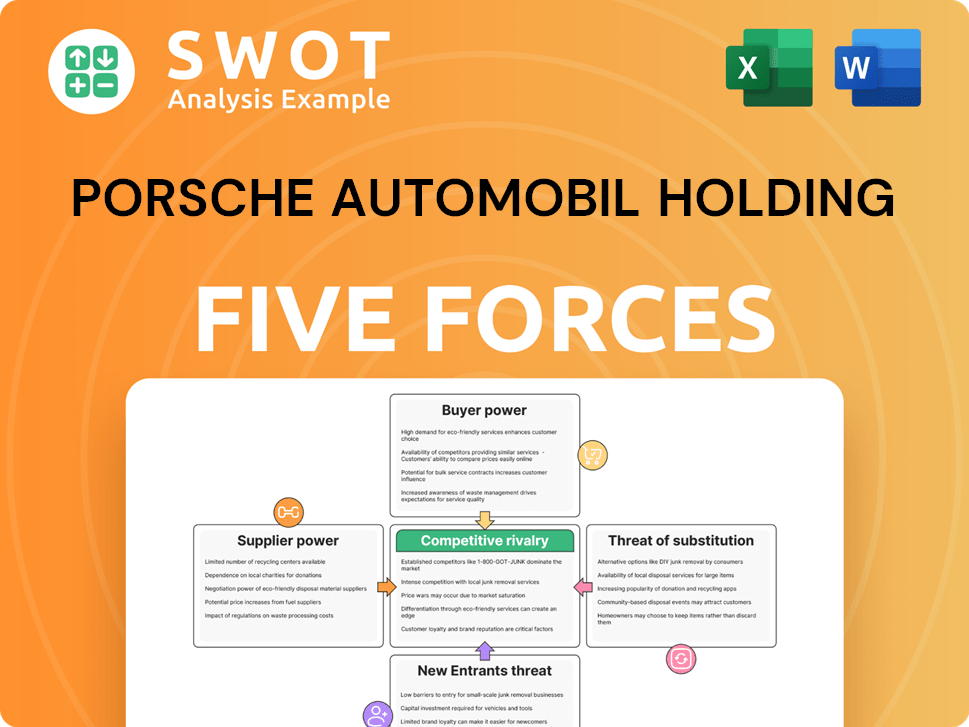
Related Blogs
- What is Competitive Landscape of Porsche Automobil Holding Company?
- What is Growth Strategy and Future Prospects of Porsche Automobil Holding Company?
- How Does Porsche Automobil Holding Company Work?
- What is Sales and Marketing Strategy of Porsche Automobil Holding Company?
- What is Brief History of Porsche Automobil Holding Company?
- Who Owns Porsche Automobil Holding Company?
- What is Customer Demographics and Target Market of Porsche Automobil Holding Company?
Disclaimer
All information, articles, and product details provided on this website are for general informational and educational purposes only. We do not claim any ownership over, nor do we intend to infringe upon, any trademarks, copyrights, logos, brand names, or other intellectual property mentioned or depicted on this site. Such intellectual property remains the property of its respective owners, and any references here are made solely for identification or informational purposes, without implying any affiliation, endorsement, or partnership.
We make no representations or warranties, express or implied, regarding the accuracy, completeness, or suitability of any content or products presented. Nothing on this website should be construed as legal, tax, investment, financial, medical, or other professional advice. In addition, no part of this site—including articles or product references—constitutes a solicitation, recommendation, endorsement, advertisement, or offer to buy or sell any securities, franchises, or other financial instruments, particularly in jurisdictions where such activity would be unlawful.
All content is of a general nature and may not address the specific circumstances of any individual or entity. It is not a substitute for professional advice or services. Any actions you take based on the information provided here are strictly at your own risk. You accept full responsibility for any decisions or outcomes arising from your use of this website and agree to release us from any liability in connection with your use of, or reliance upon, the content or products found herein.